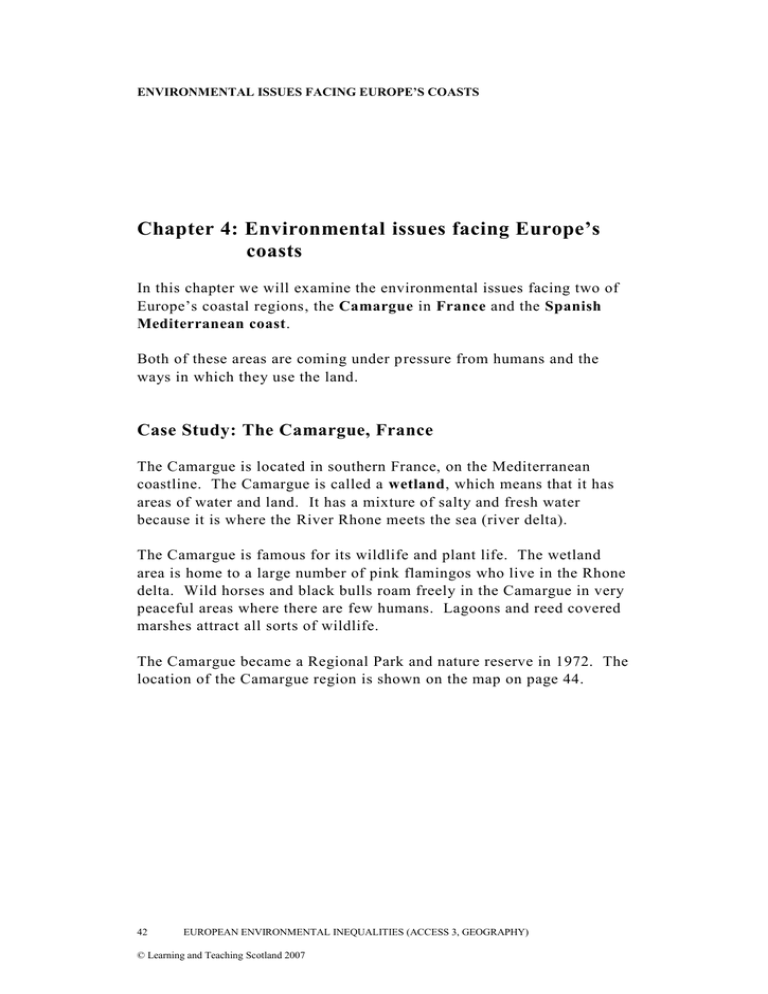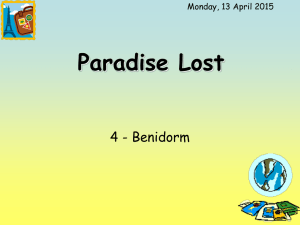Chapter 4: Environmental issues facing Europe’s coasts
advertisement

ENVIRONMENTAL ISSUES FACING EUROPE’S COASTS Chapter 4: Environmental issues facing Europe’s coasts In this chapter we will examine the environmental issues facing two of Europe’s coastal regions, the Camargue in France and the Spanish Mediterranean coast. Both of these areas are coming under pressure from humans and the ways in which they use the land. Case Study: The Camargue, France The Camargue is located in southern France, on the Mediterranean coastline. The Camargue is called a wetland, which means that it has areas of water and land. It has a mixture of salty and fresh water because it is where the River Rhone meets the sea (river delta). The Camargue is famous for its wildlife and plant life. The wetland area is home to a large number of pink flamingos who live in the Rhone delta. Wild horses and black bulls roam freely in the Camargue in very peaceful areas where there are few humans. Lagoons and reed covered marshes attract all sorts of wildlife. The Camargue became a Regional Park and nature reserve in 1972. The location of the Camargue region is shown on the map on page 44. 42 EUROPEAN ENVIRONMENTAL INEQUALITIES (ACCESS 3, GEOGRAPHY) © Learning and Teaching Scotland 2007 ENVIRONMENTAL ISSUES FACING EUROPE’S COASTS Figure 10: The Camargue Source: http://en.wikipedia.org/wiki/Image:Camargue_map.png The Camargue is a very large area that covers 500 square kilometres. The area is under pressure from lots of different land uses , including: tourism industry towns and cities farming. Environmental pressure from tourism One million tourists are attracted to the Camargue every year. They are attracted by the beautiful scenery, the wildlife and the Mediterranean climate that guarantees warm and dry weather in the summer months. It is at this time that most people visit the Camargue. Tourists can take part in a great number of activities, such as enjoying the beaches, bird watching, taking boat trips or going on safari. The great numbers of tourists results in pressure on the environment. Land is being used for tourist developments, which means a loss in wildlife habitats. There is increased noise and air pollution from the amount of tourist traffic, especially in the summer months. If too much damage is caused, wildlife will begin to disappear and people will stay away from the Camargue. This could cause a loss of jobs and money for the area. EUROPEAN ENVIRONMENTAL INEQUALITIES (ACCESS 3, GEOGRAPHY) © Learning and Teaching Scotland 2007 43 ENVIRONMENTAL ISSUES FACING EUROPE’S COASTS Activity 17 Look at the map below. It shows the number of tourists (in millions) that visit the Mediterranean each year. Figure 11: Number of tourists visiting the Mediterranean Source: SQA 44 EUROPEAN ENVIRONMENTAL INEQUALITIES (ACCESS 3, GEOGRAPHY) © Learning and Teaching Scotland 2007 ENVIRONMENTAL ISSUES FACING EUROPE’S COASTS Use the information on the map to complete and label the graph on page 45. What problems could large numbers of tourists cause in the Camargue? EUROPEAN ENVIRONMENTAL INEQUALITIES (ACCESS 3, GEOGRAPHY) © Learning and Teaching Scotland 2007 45 ENVIRONMENTAL ISSUES FACING EUROPE’S COASTS Environmental pressure from farming Forty per cent of the Camargue is used as farmland. Rice is the main cereal crop that is grown here. It is a good area for growing rice because there is fresh water available from the Rhone to flood the paddy fields where the rice grows. Lots of fresh water is taken from the Rhone to irrigate (water) crops, especially in the dry summers. Too much water from the Rhone will upset the balance between the salt and fresh water in the Camargue. This could mean that the wildlife and plant life in the Camargue could be under threat. How can this be solved? Park zoning Like any regional park, there are conflicts between the different users. To avoid any damage to animal habitats and plant life, the park has been divided into different zones. This means that farmers can only farm intensively with fertilisers and chemicals in certain parts of the Camargue. In other areas organic farming, which uses no harmful chemicals, takes place. They are both separate from areas where there are protected species, such as the pink flamingo. The pink flamingos are in a nature reserve where no farming can take place. Tourists are only allowed to access the beach area and one 20 kilometre walking trail. They are also banned from doing anything that will damage the wildlife, such as fishing or hunting. Education The park authorities are taking the time to educate tourists about how to use the Camargue in a way that will not damage the environment. It is hoped that this will allow the tourists to use the park in ways that will cause less damage because they will understand how fragile the environment is. 46 EUROPEAN ENVIRONMENTAL INEQUALITIES (ACCESS 3, GEOGRAPHY) © Learning and Teaching Scotland 2007 ENVIRONMENTAL ISSUES FACING EUROPE’S COASTS Education for tourists will be provided at local visitor centres. These centres provide different facilities for tourists such as: Trails that are open all year round in areas where little harm can be done Observation posts that give views of some spectacular sites Discovery trails, where visitors must be accompanied by a specialist . Activity 18 1. Do you think zoning of different land uses, like farming, in the Camargue is a good thing? Why? 2. Do you think that educating tourists is a good way to help stop environmental pressure in the Camargue? EUROPEAN ENVIRONMENTAL INEQUALITIES (ACCESS 3, GEOGRAPHY) © Learning and Teaching Scotland 2007 47 ENVIRONMENTAL ISSUES FACING EUROPE’S COASTS Environmental pressure from global warming When we discussed global warming in Chapter 2 we stated that some low lying areas around the coast of Europe could be affected by a rise in sea levels. The Camargue wetlands could be under serious threat from even a small rise in the levels of the Mediterranean Sea. What would happen to the Camargue? Lots of fresh water would flood the Camargue meaning that the salt water marshes would disappear. Plant and animal species could be lost. Farmland would be flooded. Activity 19 Design a poster by an environmental group showing the effects of global warming on the Camargue wetlands. Use the maps to help you. You could work in a group or with a fr iend. 48 EUROPEAN ENVIRONMENTAL INEQUALITIES (ACCESS 3, GEOGRAPHY) © Learning and Teaching Scotland 2007 ENVIRONMENTAL ISSUES FACING EUROPE’S COASTS Case Study: The Spanish Mediterranean Coast Spain is a large country with a population of 40 million people. It is located in southern Europe and the east coast of the country is bordered by the Mediterranean Sea. Figure 12: Location of Spain in Europe The Spanish Mediterranean coast EUROPEAN ENVIRONMENTAL INEQUALITIES (ACCESS 3, GEOGRAPHY) © Learning and Teaching Scotland 2007 49 ENVIRONMENTAL ISSUES FACING EUROPE’S COASTS Spain is one of the most popular holiday destinations in the world. The Mediterranean coast of Spain attracts around 65 million tourists every year. They are attracted by the warm and dry summer climate and by the beautiful beaches and warm Mediterranean Sea. The Spanish Mediterranean coast is under environmental pressure from the amount of tourists who flock to this coastline each year. Tourism is a large part of the industry in Spain and many small fishing villages have grown very quickly into large tourist resorts. 50 EUROPEAN ENVIRONMENTAL INEQUALITIES (ACCESS 3, GEOGRAPHY) © Learning and Teaching Scotland 2007 ENVIRONMENTAL ISSUES FACING EUROPE’S COASTS Activity 20 Find a map of Spain in an atlas. Label the map below with the information given in the table. Shade the highland areas brown. Label the following cities and resorts. The Pyrenees The Sierra Nevada Cantabrian Mountains Label the following rivers, seas and coastal areas. River Ebro Mediterranean Sea River Guadalquivir Costa Brava Costa Blanca Costa del Sol Label the Balearic Islands. Madrid Barcelona Zaragoza Seville Malaga Lloret de Mar Salou Valencia Benidorm Alicante Torremolinos Bilbao La Coruna Almeria Ibiza Majorca Menorca EUROPEAN ENVIRONMENTAL INEQUALITIES (ACCESS 3, GEOGRAPHY) © Learning and Teaching Scotland 2007 51 ENVIRONMENTAL ISSUES FACING EUROPE’S COASTS The Spanish Mediterranean climate The climate of an area is made up of averages for temperature and rainfall over a long period of time. In summer months the pleasant climate of Spain attracts lots of tourists to visit and enjoy a holiday in the sun. The graph below shows average temperatures for Benidorm, a popular tourist destination on the Spanish coast, and London. Figure 13: Temperature on the Spanish coast Benidorm London 52 EUROPEAN ENVIRONMENTAL INEQUALITIES (ACCESS 3, GEOGRAPHY) © Learning and Teaching Scotland 2007 ENVIRONMENTAL ISSUES FACING EUROPE’S COASTS Activity 21 Examine the temperature graph on page 53 and answer the questions below. 1. 2. 3. What are the highest and lowest temperatures in Benidorm and in what months do they occur? Highest: Month: Lowest: Month: What are the highest and lowest temperatures in London and in what months do they occur? Highest: Month: Lowest: Month: Looking at the graph, can you spot any similarities and differences between the temperature for Benidorm and London? EUROPEAN ENVIRONMENTAL INEQUALITIES (ACCESS 3, GEOGRAPHY) © Learning and Teaching Scotland 2007 53 ENVIRONMENTAL ISSUES FACING EUROPE’S COASTS 4. The figures in the table below show rainfall in millimetres for Benidorm and London. Use the figures to complete the bar graph. F M A M J J A S O N D Benidorm 31 39 48 43 54 37 27 49 76 86 52 45 London 61 36 50 42 45 46 46 44 43 73 45 59 Rainfall in mm J Months 54 EUROPEAN ENVIRONMENTAL INEQUALITIES (ACCESS 3, GEOGRAPHY) © Learning and Teaching Scotland 2007 ENVIRONMENTAL ISSUES FACING EUROPE’S COASTS 5. Using the information about rainfall and temperature, explain why Benidorm on the Spanish Mediterranean coast is a popular tourist destination. EUROPEAN ENVIRONMENTAL INEQUALITIES (ACCESS 3, GEOGRAPHY) © Learning and Teaching Scotland 2007 55 ENVIRONMENTAL ISSUES FACING EUROPE’S COASTS Environmental pressure from tourism Many small fishing villages on the Spanish Mediterrane an coast have been transformed into popular beach resorts. One example of a town like this is Benidorm. The town of Benidorm is located on the Costa Blanca, ‘the White Coast’, one-hours’ drive from the main airport in the region, Alicante. The locatio n of Benidorm is show on the map below. Figure 14: Location of Benidorm Benidorm Source: http://geography.about.com/library/cia/blcspain.htm Lots of tourists began to visit to Benidorm in the 1960s and 70s. To cope with the number of visitors the town began to grow very quickly to provide facilities for the tourists. The area of flat land behind the two beaches has developed into a ‘strip’ of high-rise hotels and apartment blocks. 56 EUROPEAN ENVIRONMENTAL INEQUALITIES (ACCESS 3, GEOGRAPHY) © Learning and Teaching Scotland 2007 ENVIRONMENTAL ISSUES FACING EUROPE’S COASTS The traditional look of the village has been lost; hotels, restaurants, bars, shops and nightclubs line the beachfront. Roads have been improved to allow tourists easy access to the airport in Alicante , which means increased traffic and pollution. The photo below shows what Benidorm looks like now. Figure 15: Modern Benidorm EUROPEAN ENVIRONMENTAL INEQUALITIES (ACCESS 3, GEOGRAPHY) © Learning and Teaching Scotland 2007 57 ENVIRONMENTAL ISSUES FACING EUROPE’S COASTS Water pollution is a problem in coastal resorts such as Benidorm. During the summer months there is a big increase in the number of people staying in the resort; therefore, the amount of sewage that gets dumped into the sea increases. When people come into contact with sewage that has not been treated properly it can cause the spread of disease such as hepatitis and typhoid. Another water-related problem that tourist resorts on the Spanish Mediterranean coast face is that there is not enough water to cop e with the demand from tourists. Tourists need water for swimming pools, baths and showers. Water is taken from aquifers, a natural underground water store, which means that the water levels in the ground are falling. Farmers have no water left to use to water (irrigate) their land. Water for Benidorm has to be piped from rivers inland. Problems of development As a result of the massive development of Benidorm, it began to get a poor image so tourists stayed away in the 1990s. The picture below shows some of the problems that Benidorm faced. Figure 16: Problems in Benidorm Source: R Gallagher and R Parish, 2002, Geography 3 58 EUROPEAN ENVIRONMENTAL INEQUALITIES (ACCESS 3, GEOGRAPHY) © Learning and Teaching Scotland 2007 ENVIRONMENTAL ISSUES FACING EUROPE’S COASTS Activity 22 Look at Figure 16. Explain why many tourists are put off going to Benidorm. The Spanish government had to act fast to save the reputation of Benidorm. Benidorm is very important to the economy of Spain because it provides lots of job in the area and makes a lot of money. What has been done? The European Union The EU awards beaches that are very clean with ‘Blue Flags’. Both beaches in Benidorm have been awarded blue flags for the cleanliness of their water. The EU gives countries advice on how to treat sewage and make sure that the beaches remain clean. Environmental groups Environmental groups, like Greenpeace, put pressure on resorts to keep beaches and water clean. They also work together with organisations such as Tourism Concern to encourage sustainable tourism. This means encouraging tourism that does not harm the environment and keeps it safe for future generations. To promote sustainable tourism, the government has more control over new development. Hotels are being refurbished and new hotels have to meet strict standards. EUROPEAN ENVIRONMENTAL INEQUALITIES (ACCESS 3, GEOGRAPHY) © Learning and Teaching Scotland 2007 59 ENVIRONMENTAL ISSUES FACING EUROPE’S COASTS The diagram below shows different environmental pressures on coastal tourist resorts. Figure 17: A model coastal resort Source: SQA Activity 23 Look at the diagram above of the model coastal resort. 1. 60 Write down any similarities between the model resort and Benidorm (look at Figures 14, 15 and 16). EUROPEAN ENVIRONMENTAL INEQUALITIES (ACCESS 3, GEOGRAPHY) © Learning and Teaching Scotland 2007 ENVIRONMENTAL ISSUES FACING EUROPE’S COASTS 2. Select two environmental pressures that can affect the landscape. Explain what problems can be created by this pressure. Pressure 1: Pressure 2: 3. For one of the environmental pressures, describe how the European Union or an environmental group can reduce the problem. EUROPEAN ENVIRONMENTAL INEQUALITIES (ACCESS 3, GEOGRAPHY) © Learning and Teaching Scotland 2007 61 ENVIRONMENTAL ISSUES FACING EUROPE’S COASTS Comparison: The Camargue and the Spanish Mediterranean coast Activity 24 1. In the space below write about the location and main features of each coastal area. Write about: 62 The location of each coastal area Main features of each coastal area Any similarities or differences between them EUROPEAN ENVIRONMENTAL INEQUALITIES (ACCESS 3, GEOGRAPHY) © Learning and Teaching Scotland 2007 ENVIRONMENTAL ISSUES FACING EUROPE’S COASTS 2. Describe the impact of tourism on the Camargue and a resort on the Spanish Mediterranean coast. Write about: What the attractions of each area are The benefits of tourism EUROPEAN ENVIRONMENTAL INEQUALITIES (ACCESS 3, GEOGRAPHY) © Learning and Teaching Scotland 2007 63 ENVIRONMENTAL ISSUES FACING EUROPE’S COASTS 3. Describe problems of development in the two coastal areas. Write about: Farming in the Camargue Urban development in Benidorm on the Spanish Mediterranean coast 64 EUROPEAN ENVIRONMENTAL INEQUALITIES (ACCESS 3, GEOGRAPHY) © Learning and Teaching Scotland 2007 ENVIRONMENTAL ISSUES FACING EUROPE’S COASTS 4. What is being done to ease environmental pressure in the Camargue and Benidorm on the Spanish Mediterranean coast? Write about: How the areas are protected Do you think these methods are successful? EUROPEAN ENVIRONMENTAL INEQUALITIES (ACCESS 3, GEOGRAPHY) © Learning and Teaching Scotland 2007 65


